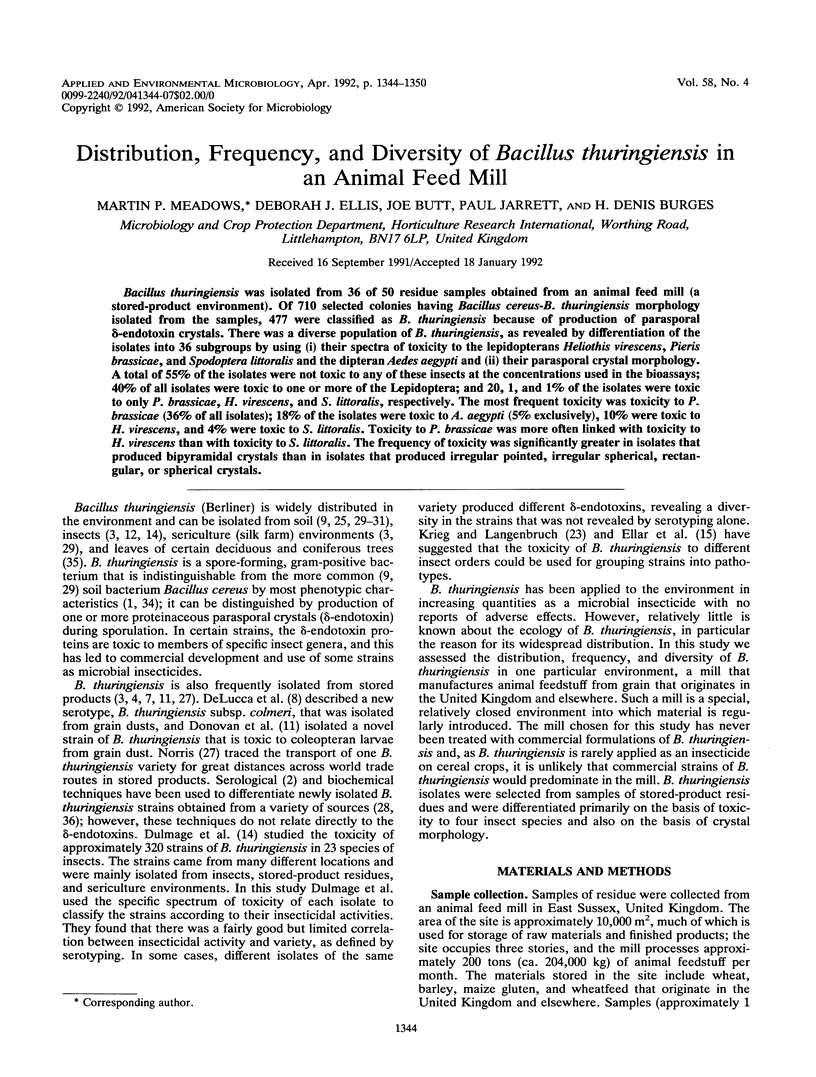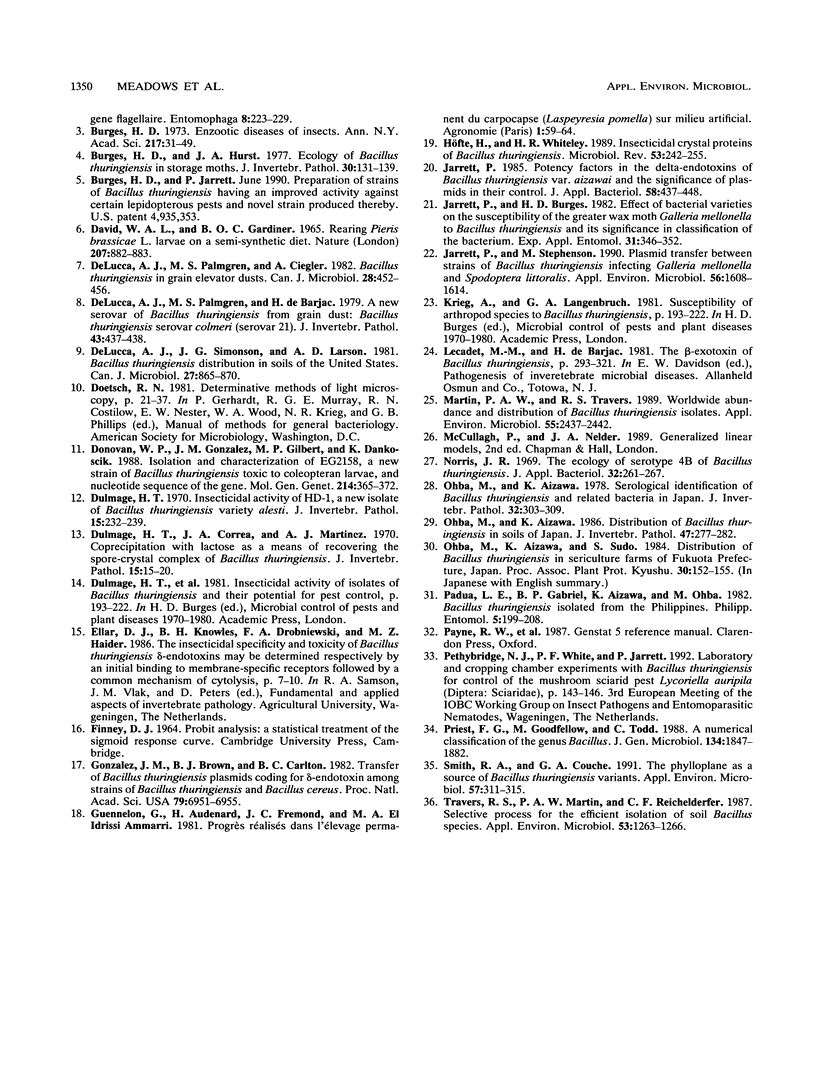Abstract
Bacillus thuringiensis was isolated from 36 of 50 residue samples obtained from an animal feed mill (a stored-product environment). Of 710 selected colonies having Bacillus cereus-B. thuringiensis morphology isolated from the samples, 477 were classified as B. thuringiensis because of production of parasporal δ-endotoxin crystals. There was a diverse population of B. thuringiensis, as revealed by differentiation of the isolates into 36 subgroups by using (i) their spectra of toxicity to the lepidopterans Heliothis virescens, Pieris brassicae, and Spodoptera littoralis and the dipteran Aedes aegypti and (ii) their parasporal crystal morphology. A total of 55% of the isolates were not toxic to any of these insects at the concentrations used in the bioassays; 40% of all isolates were toxic to one or more of the Lepidoptera; and 20, 1, and 1% of the isolates were toxic to only P. brassicae, H. virescens, and S. littoralis, respectively. The most frequent toxicity was toxicity to P. brassicae (36% of all isolates); 18% of the isolates were toxic to A. aegypti (5% exclusively), 10% were toxic to H. virescens, and 4% were toxic to S. littoralis. Toxicity to P. brassicae was more often linked with toxicity to H. virescens than with toxicity to S. littoralis. The frequency of toxicity was significantly greater in isolates that produced bipyramidal crystals than in isolates that produced irregular pointed, irregular spherical, rectangular, or spherical crystals.
Full text
PDF






Selected References
These references are in PubMed. This may not be the complete list of references from this article.
- Burges H. D. Enzootic diseases of insects. Ann N Y Acad Sci. 1973 Jun 22;217:31–49. doi: 10.1111/j.1749-6632.1973.tb32746.x. [DOI] [PubMed] [Google Scholar]
- DeLucca A. J., 2nd, Simonson J. G., Larson A. D. Bacillus thuringiensis distribution in soils of the United States. Can J Microbiol. 1981 Sep;27(9):865–870. doi: 10.1139/m81-137. [DOI] [PubMed] [Google Scholar]
- Donovan W. P., Gonzalez J. M., Jr, Gilbert M. P., Dankocsik C. Isolation and characterization of EG2158, a new strain of Bacillus thuringiensis toxic to coleopteran larvae, and nucleotide sequence of the toxin gene. Mol Gen Genet. 1988 Nov;214(3):365–372. doi: 10.1007/BF00330468. [DOI] [PubMed] [Google Scholar]
- Dulmage H. T., Correa J. A., Martinez A. J. Coprecipitation with lactose as a means of recovering the sporte-crystal complex of Bacillus thuringiensis. J Invertebr Pathol. 1970 Jan;15(1):15–20. doi: 10.1016/0022-2011(70)90093-5. [DOI] [PubMed] [Google Scholar]
- González J. M., Jr, Brown B. J., Carlton B. C. Transfer of Bacillus thuringiensis plasmids coding for delta-endotoxin among strains of B. thuringiensis and B. cereus. Proc Natl Acad Sci U S A. 1982 Nov;79(22):6951–6955. doi: 10.1073/pnas.79.22.6951. [DOI] [PMC free article] [PubMed] [Google Scholar]
- Höfte H., Whiteley H. R. Insecticidal crystal proteins of Bacillus thuringiensis. Microbiol Rev. 1989 Jun;53(2):242–255. doi: 10.1128/mr.53.2.242-255.1989. [DOI] [PMC free article] [PubMed] [Google Scholar]
- Jarrett P., Stephenson M. Plasmid transfer between strains of Bacillus thuringiensis infecting Galleria mellonella and Spodoptera littoralis. Appl Environ Microbiol. 1990 Jun;56(6):1608–1614. doi: 10.1128/aem.56.6.1608-1614.1990. [DOI] [PMC free article] [PubMed] [Google Scholar]
- Martin P. A., Travers R. S. Worldwide Abundance and Distribution of Bacillus thuringiensis Isolates. Appl Environ Microbiol. 1989 Oct;55(10):2437–2442. doi: 10.1128/aem.55.10.2437-2442.1989. [DOI] [PMC free article] [PubMed] [Google Scholar]
- Norris J. R. The ecology of serotype 4B of Bacillus thuringiensis. J Appl Bacteriol. 1969 Jun;32(2):261–267. doi: 10.1111/j.1365-2672.1969.tb00973.x. [DOI] [PubMed] [Google Scholar]
- Priest F. G., Goodfellow M., Todd C. A numerical classification of the genus Bacillus. J Gen Microbiol. 1988 Jul;134(7):1847–1882. doi: 10.1099/00221287-134-7-1847. [DOI] [PubMed] [Google Scholar]
- Quraishi M. S. Hatching pattern of Aedes aegypti eggs. Nature. 1965 Aug 21;207(999):882–882. doi: 10.1038/207882a0. [DOI] [PubMed] [Google Scholar]
- Smith R. A., Couche G. A. The Phylloplane as a Source of Bacillus thuringiensis Variants. Appl Environ Microbiol. 1991 Jan;57(1):311–315. doi: 10.1128/aem.57.1.311-315.1991. [DOI] [PMC free article] [PubMed] [Google Scholar]
- Travers R. S., Martin P. A., Reichelderfer C. F. Selective Process for Efficient Isolation of Soil Bacillus spp. Appl Environ Microbiol. 1987 Jun;53(6):1263–1266. doi: 10.1128/aem.53.6.1263-1266.1987. [DOI] [PMC free article] [PubMed] [Google Scholar]


